The Creatinine Meter Market is estimated to be valued at USD 832.5 million in 2025 and is projected to reach USD 1899.8 million by 2035, registering a compound annual growth rate (CAGR) of 8.6% over the forecast period.
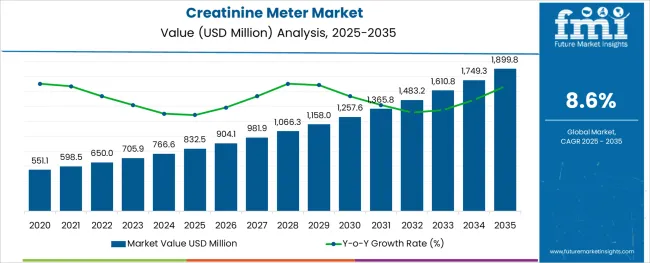
The creatinine meter market is expanding steadily, driven by the growing need for rapid and accurate kidney function testing in clinical and outpatient settings. Advances in medical diagnostics have increased the demand for point-of-care testing devices that offer convenience and timely results. The rise in chronic kidney disease prevalence and the emphasis on early diagnosis have encouraged healthcare providers to adopt portable creatinine meters.
Improved accessibility and affordability of handheld devices have further broadened their application in remote and resource-limited areas. Additionally, healthcare initiatives promoting preventive care and chronic disease management have supported market growth.
Technological improvements focusing on device accuracy, ease of use, and connectivity with digital health systems are expected to enhance market prospects. Segmental growth is expected to be led by creatinine meters as the core product type, handheld devices for their portability, and point-of-care use as the primary end-use segment.
The market is segmented by Product, Modularity, and End Use and region. By Product, the market is divided into Creatinine Meters, Reagents, and Sensor Strips & Kits. In terms of Modularity, the market is classified into Handheld and Desktop. Based on End Use, the market is segmented into Point of Care Use, Hospitals, Diagnostic Laboratories, and Others. Regionally, the market is classified into North America, Latin America, Western Europe, Eastern Europe, Balkan & Baltic Countries, Russia & Belarus, Central Asia, East Asia, South Asia & Pacific, and the Middle East & Africa.
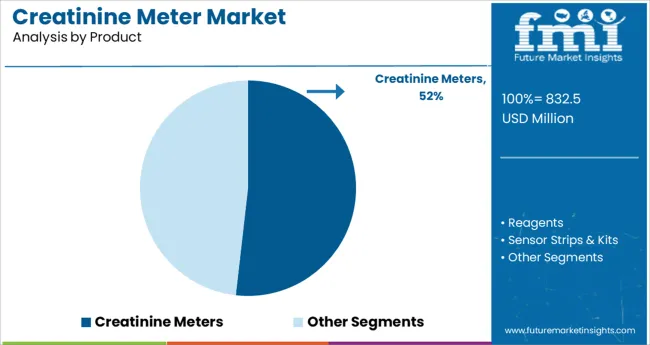
The creatinine meters segment is projected to hold 51.8% of the creatinine meter market revenue in 2025, maintaining its leading product category status. The growth of this segment has been driven by the clinical necessity to monitor kidney function efficiently across diverse healthcare environments. Creatinine meters provide rapid quantification of creatinine levels, facilitating early detection of kidney impairment.
Their accuracy and ease of operation have encouraged adoption in laboratories, clinics, and home settings. Increasing focus on personalized medicine and chronic disease management has heightened demand for such devices that enable frequent and reliable monitoring.
Ongoing innovations in sensor technology and assay methods are further enhancing the performance of creatinine meters. This segment’s leadership is expected to continue as healthcare providers prioritize timely kidney health assessments.
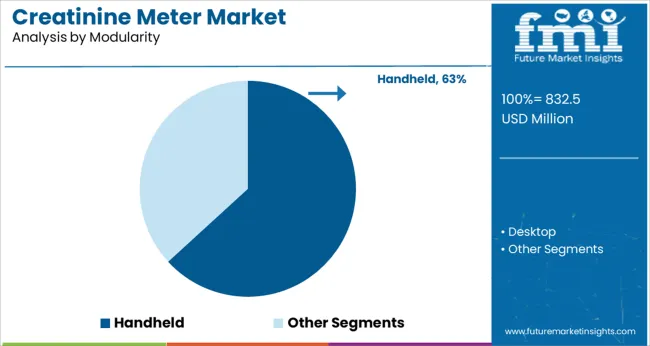
The handheld segment is expected to capture 63.2% of the creatinine meter market revenue in 2025, reflecting its dominant position. The preference for handheld devices is driven by their portability, user-friendly interfaces, and suitability for bedside and remote testing.
Healthcare professionals appreciate the convenience of handheld creatinine meters in fast-paced environments such as emergency rooms and outpatient clinics. The compact size allows for easy transport and use in home healthcare settings, improving patient monitoring outside traditional facilities.
Handheld devices have also benefited from advancements in battery technology and wireless connectivity, enabling integration with digital health platforms for data tracking and telemedicine. As healthcare delivery models evolve towards decentralized testing, handheld creatinine meters are expected to remain highly sought after.

Point of care use is projected to account for 42.5% of the creatinine meter market revenue in 2025, establishing itself as the leading end-use segment. This segment’s growth is propelled by the increasing demand for immediate diagnostic results to support clinical decision-making and patient management.
Point-of-care testing reduces turnaround times compared to centralized laboratories and enables timely intervention in acute and chronic kidney conditions. Healthcare providers in outpatient clinics, dialysis centers, and emergency departments rely heavily on point-of-care creatinine meters to monitor patient status efficiently.
The trend towards value-based care and improving patient outcomes has reinforced the importance of point-of-care diagnostics. With continued emphasis on rapid testing solutions that enhance care delivery, the point-of-care use segment is expected to sustain its leadership in the creatinine meter market.
Commonly, it takes several hours to test creatinine at clinical labs. In addition, the risk of patients with specific conditions is high in clinical testing due to imaging agents like iodine and barium, which are generally used in radiological procedures.
On the other hand, creatinine meters allow healthcare professionals to get precise quantitative results for creatinine tests within minutes with ease of use. On account of this, a swift inclination towards adopting creatinine meters, particularly handheld devices, is being witnessed across the healthcare sector worldwide for the testing of kidney and renal disorders, bolstering the demand in the global market.
Although there are several advantages associated with using creatinine meters, the high cost of this equipment, specifically handheld creatinine meters, and the need for skilled professionals to assess the ratings are hindering sales in the global market. In addition to this, the availability of low-cost creatinine testing solutions and equipment is further hampering the demand for creatinine meters in the market.
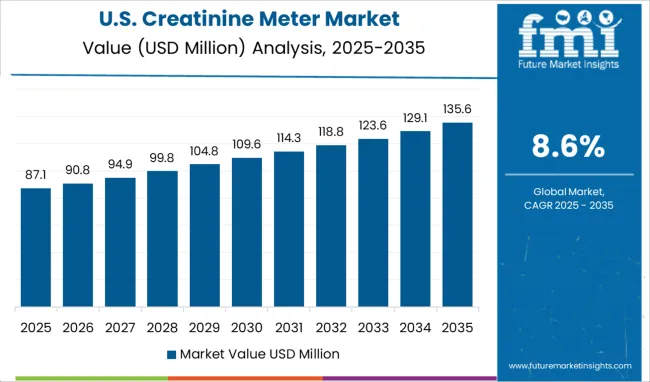
As per FMI, North America is forecast to emerge as the most lucrative market for creatinine meters between 2025 and 2035.
Demand for creatinine meters is increasing rapidly across the medical sector due to the increasing usage in renal dialysis monitoring and measurement of blood and urine analytes. Thus, leading players in the market are focusing on launching novel products to cater to this growing demand.
For instance, in 2025, Nova Biomedical, a USA - based manufacturer of medical diagnostics equipment, announced launching a new easy-to-use meter creatinine, Nova Max Pro Creatinine/eGFR Meter System, capable of early detection of kidney disease and kidney function screening in point-of-care settings. A slew of such new product launches is estimated to augment the sales in the North American market.

Future Market Insights predicts that Europe will exhibit rapid growth in the global creatinine meter market from 2025 to 2035.
The burden of chronic kidney diseases and renal disorders is rapidly increasing across Europe, owing to changing eating habits, rising obesity, and smoking. According to a study by the Kidney Care Organization, nearly 10% of the UK population, or more than 6.5 Million people in the country, are estimated to be suffering from chronic kidney diseases.
Creatinine meters are extensively used in the diagnosis and treatment of these diseases. The growing prevalence of chronic kidney diseases is projected to propel the demand for them in the European market.
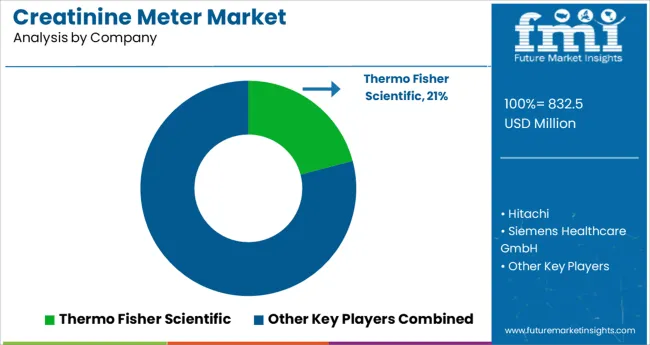
Some of the leading players in the creatinine meter market are Thermo Fisher Scientific, Hitachi, Siemens Healthcare GmbH, Randox Laboratories, Abbott, Nova Biomedical, Pointe Scientific, Diasys Diagnostic Systems GmbH, Sentinel Ch. Spa., and others.
Prominent players in the global creatinine meter market are aiming to introduce novel potable and easy-to-use products for point-of-care use to gain an edge in the highly competitive market.
| Report Attribute | Details |
|---|---|
| Growth Rate | CAGR of 8% to 9% from 2025 to 2035 |
| Base Year for Estimation | 2024 |
| Historical Data | 2020 to 2024 |
| Forecast Period | 2025 to 2035 |
| Quantitative Units | Revenue in million, Volume in Kilotons, and CAGR from 2025 to 2035 |
| Report Coverage | Revenue Forecast, Volume Forecast, Company Ranking, Competitive Landscape, Growth Factors, Trends and Pricing Analysis |
| Segments Covered | Product, Modularity, End Use, Region |
| Countries Covered | North America; Latin America; Europe; CIS & Russia; APEJ; Japan; Middle East and Africa |
| Key Companies Profiled | Thermo Fisher Scientific; Hitachi; Siemens Healthcare GmbH; Randox Laboratories; Abbott; Nova Biomedical; Pointe Scientific; Diasys Diagnostic Systems GmbH; Sentinel Ch. Spa.; Others |
| Customization | Available Upon Request |
The global creatinine meter market is estimated to be valued at USD 832.5 million in 2025.
It is projected to reach USD 1,899.8 million by 2035.
The market is expected to grow at a 8.6% CAGR between 2025 and 2035.
The key product types are creatinine meters, reagents and sensor strips & kits.
handheld segment is expected to dominate with a 63.2% industry share in 2025.






Our Research Products

The "Full Research Suite" delivers actionable market intel, deep dives on markets or technologies, so clients act faster, cut risk, and unlock growth.

The Leaderboard benchmarks and ranks top vendors, classifying them as Established Leaders, Leading Challengers, or Disruptors & Challengers.

Locates where complements amplify value and substitutes erode it, forecasting net impact by horizon

We deliver granular, decision-grade intel: market sizing, 5-year forecasts, pricing, adoption, usage, revenue, and operational KPIs—plus competitor tracking, regulation, and value chains—across 60 countries broadly.

Spot the shifts before they hit your P&L. We track inflection points, adoption curves, pricing moves, and ecosystem plays to show where demand is heading, why it is changing, and what to do next across high-growth markets and disruptive tech

Real-time reads of user behavior. We track shifting priorities, perceptions of today’s and next-gen services, and provider experience, then pace how fast tech moves from trial to adoption, blending buyer, consumer, and channel inputs with social signals (#WhySwitch, #UX).

Partner with our analyst team to build a custom report designed around your business priorities. From analysing market trends to assessing competitors or crafting bespoke datasets, we tailor insights to your needs.
Supplier Intelligence
Discovery & Profiling
Capacity & Footprint
Performance & Risk
Compliance & Governance
Commercial Readiness
Who Supplies Whom
Scorecards & Shortlists
Playbooks & Docs
Category Intelligence
Definition & Scope
Demand & Use Cases
Cost Drivers
Market Structure
Supply Chain Map
Trade & Policy
Operating Norms
Deliverables
Buyer Intelligence
Account Basics
Spend & Scope
Procurement Model
Vendor Requirements
Terms & Policies
Entry Strategy
Pain Points & Triggers
Outputs
Pricing Analysis
Benchmarks
Trends
Should-Cost
Indexation
Landed Cost
Commercial Terms
Deliverables
Brand Analysis
Positioning & Value Prop
Share & Presence
Customer Evidence
Go-to-Market
Digital & Reputation
Compliance & Trust
KPIs & Gaps
Outputs
Full Research Suite comprises of:
Market outlook & trends analysis
Interviews & case studies
Strategic recommendations
Vendor profiles & capabilities analysis
5-year forecasts
8 regions and 60+ country-level data splits
Market segment data splits
12 months of continuous data updates
DELIVERED AS:
PDF EXCEL ONLINE
Metering Pump Market Size and Share Forecast Outlook 2025 to 2035
Metered Dose Squeeze Dispenser Market Size and Share Forecast Outlook 2025 to 2035
The Metered Dose Inhalers Market is Segmented by Type, and End User from 2025 to 2035
Cemetery Software Market Size and Share Forecast Outlook 2025 to 2035
Ammeters Market Size and Share Forecast Outlook 2025 to 2035
Diameter Signaling Market Size and Share Forecast Outlook 2025 to 2035
Odometer Market Trends – Growth & Forecast 2025 to 2035
pH Meter Market Growth – Trends & Forecast 2019-2027
Bolometer Market Size and Share Forecast Outlook 2025 to 2035
Barometer Market Size and Share Forecast Outlook 2025 to 2035
Ohm Meter Market Size and Share Forecast Outlook 2025 to 2035
Durometer Market Size and Share Forecast Outlook 2025 to 2035
Ergometers Market Size and Share Forecast Outlook 2025 to 2035
Rheometers Market Size and Share Forecast Outlook 2025 to 2035
LCR Meters Market Analysis - Size, Share, and Forecast Outlook 2025 to 2035
Gas Meters Market Growth - Trends & Forecast 2025 to 2035
AI-Secured Perimeters – Advanced Intrusion Detection Solutions
Manometers Market
Pyrometer Market
TDS Meter Market Growth – Trends & Forecast 2019-2027

Thank you!
You will receive an email from our Business Development Manager. Please be sure to check your SPAM/JUNK folder too.
Chat With
MaRIA